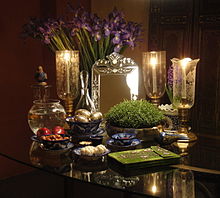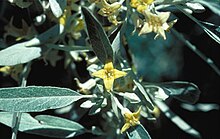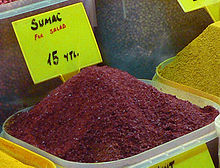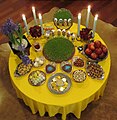Haft-sin

Haft-sin or Haft-seen (Template:Lang-fa) is an arrangement of seven symbolic items whose names start with the letter "س" pronounced as "seen" the 15th letter in the Persian alphabet; haft (هفت) is Persian for seven.[1][2] It is traditionally displayed at Nowruz, the Iranian New Year, which is celebrated on the day of the vernal equinox, marking the beginning of spring on the Northern Hemisphere.
Items of Haft Seen
The following are the primary items of Haft-sin, whose Persian names begin with the letter sin in the Persian alphabet.[1][2]
- Sabzeh (سبزه) – wheat, barley, mung bean, or lentil sprouts grown in a dish.
- Samanu (سمنو) – wheat germ sweet pudding.
- Senjed (سنجد) – Persian olive.
- Serkeh (سرکه) – vinegar.
- Seeb (سیب) – apple.
- Seer (سیر) – garlic.
- Somāq (سماق) – sumac.



Coins (سکه sekke), hyacinth (سنبل sonbol), and clock (ساعت saat) are sometimes included too. Other symbolic items that are typically used to accompany Haft-sin include a mirror, candles, painted eggs, goldfish, and traditional Persian confectioneries.
A "book of wisdom" is also commonly included, which might be the Quran, the Bible, the Avesta, the Shahnameh, or the divān of Hafez.[1]
Symbolic Roots of Haft Seen
The Haft-Seen table represents nature. By tradition, Iranian families take great pains to create the most beautiful Haft-Seen table that they can, for not only does it embody values both traditional and spiritual, it is also appreciated by the visitors during Nowruz visiting exchanges as a reflection of the families' aesthetic sense and good taste.
Items that start with Persian letter "س":
- Sabzeh (سبزه): the symbol of rebirth and growth.
- Samanu (سمنو): the symbol of power and strength.
- Senjed (سنجد): the symbol of love.
- Somāq (سماق): the symbol of sunrise.
- Serkeh (سرکه): the symbol of patience.
- Seeb (سیب): the symbol of beauty.
- Seer (سیر): the symbol of health and medicine.
Other items that start with Persian letter "س" that are sometimes included:
- Sonbol (سنبل): the symbol of spring's arrival.
- Sekkeh (سکه): the symbol of wealth and prosperity.
- Saat (ساعت): the symbol of time.
Items that don't start with "س" but, nonetheless, are invariably included:
- eggs (تخممرغ رنگی): the symbol of fertility.
- mirror (آینه): the symbol of self-reflection.
- candle (شمع): the symbol of enlightenment.
- goldfish (ماهی قرمز): the symbol of progress.
- book (کتاب): the symbol of wisdom.
Afghan Haft Mewa
In Afghanistan, people prepare Haft Mēwa (Template:Lang-fa) (literally translates as Seven Fruits) in addition to or instead of Haft Seen which is common in Iran. Haft Mewa is like a fruit salad made from seven different dried fruits, served in their own syrup. The seven dried fruits are: raisins, Senjed (the dried fruit of the oleaster tree), pistachios, hazelnuts, prunes (dried apricots), walnuts and either almonds or another species of plum fruit.
Gallery
-
Wheatgrass, one of the items of Haft-sin.
-
A bowl of samanu, one of the items of Haft-sin.
-
Goldfish, one of the items of Haft-sin.
-
A Haft-sin table at the White House.
-
A Haft-sin table at a hotel in Tehran.
-
A Haft-sin table at Sharif University of Technology.
-
A Haft-sin table.
-
A Haft-sin table.
-
A Haft-sin table.
-
A Haft-sin table.
-
A Haft-sin table.
-
A Haft-sin table.
-
A Haft-sin table.
-
A Haft-sin table.
See also
- Passover Seder plate, an aesthetically similar (except for its element of animal sacrifice, a practice strictly banned by Zoroastrians) display for the Jewish holiday of Passover.
References
External links
- Shahbazi, A. Shapur (March 1, 2012). "HAFT SIN". Encyclopaedia Iranica. Vol. XI. pp. 524–526.














